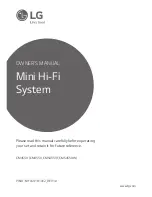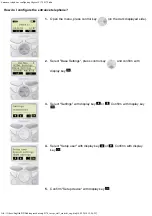
With regard to wireless microphone applications,
unidirectional antennas are typically only employed in
UHF systems. Directional antennas are somewhat
frequency specific, so some care must be taken in
selecting the proper antenna to cover the required
frequencies. A directional VHF antenna is 3-5 feet
(1-2 m) wide (just like a roof-mounted television
antenna), which makes mounting a mechanically
cumbersome task. Note that these antennas should be
mounted with the transverse elements in the vertical
direction, rather than horizontal as in a television
application, because the transmitting antennas are
usually also vertical. Unidirectional antennas are
primarily used for long range applications. A minimum
distance of 50 feet (15 m) is recommended between
transmitter and unidirectional antennas.
ANTENNA PLACEMENT
Most wireless receivers have their primary antenna
inputs on the back of the receiver. Since diversity receivers
are discussed here almost exclusively, there will be both
an A antenna input and a B antenna input on the rear
panel of the receiver. BNC connections are most often
used for antenna inputs, although some older (primarily
VHF) systems may have used PL-259 connectors.
Rack-mountable receivers often provide pre-cut holes on
the rack ears to accommodate antenna connections for
front-mounting the antennas. Short coaxial cables and
bulkhead adapters with the proper connector type are all
that is needed to bring the antennas to the front.
When deciding where to mount antennas, always try
to maintain line of sight between the receiving and
transmitting antennas. For example, if the back of the rack
faces the performance area, then rear-mounting the
antennas will provide better line of sight. If the front of the
rack faces the performance area, then front-mounting may
be better, unless a front door to the rack needs to be
closed. Metal equipment racks will block RF from reaching
the antennas mounted inside. Rear-mounted antennas
may not work inside of a metal equipment rack. If the
receiver is not rack-mounted at all, then simply maintain
line of sight, that is, the receiving antennas should be
directly visible from the transmitting position.
Antenna Spacing
Antennas should be separated from each other by a
minimum of one quarter wavelength – about 16 inches (40
cm) for VHF units and about 4 inches (10 cm) for UHF
units. This helps ensure adequate diversity performance.
Diversity reception can be improved by separating
the antennas further, but beyond one full wavelength
the advantage becomes negligible. However, greater
separation may be useful if it results in more strategic
antenna location. For example, increasing separation to
ensure line-of-sight with at least one of the antennas from
any location in the room.
6
ANTENNA SETUP
Wireless Systems Guide for
1/2 wave
(with amplifier)
log periodic
Summary:
• 1/4-wave antenna – must be mounted on
receiver; do not remote mount.
• 1/2-wave antenna – suitable for remote
applications.
• Unidirectional antenna – also suitable for
remote mount, provides additional gain.
VHF: 16”
UHF: 4”
Adequate spacing
Minimum:
> 1/4 wavelength
Best:
> 1 wavelength
Summary of Contents for ANTENNA SETUP
Page 2: ......





































